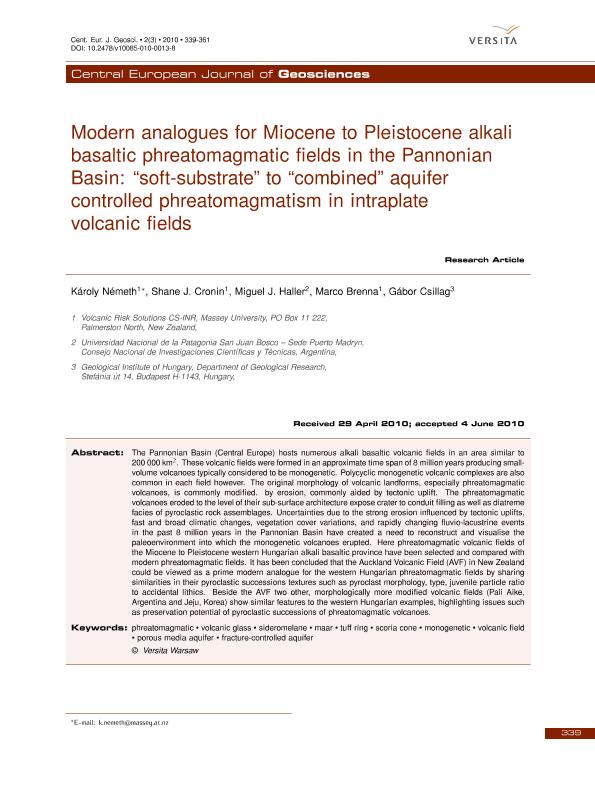Artículo
Modern analogues for Miocene to Pleistocene alkali basaltic phreatomagmatic fields in the Pannonian Basin: "Soft-substrate" to "combined" aquifer controlled phreatomagmatism in intraplate volcanic fields
Fecha de publicación:
09/2010
Editorial:
De Gruyter
Revista:
Central European Journal of Geosciences
ISSN:
2081-9900
e-ISSN:
1896-1517
Idioma:
Inglés
Tipo de recurso:
Artículo publicado
Clasificación temática:
Resumen
The Pannonian Basin (Central Europe) hosts numerous alkali basaltic volcanic fields in an area similar to 200 000 km2. These volcanic fields were formed in an approximate time span of 8 million years producing smallvolume volcanoes typically considered to be monogenetic. Polycyclic monogenetic volcanic complexes are also common in each field however. The original morphology of volcanic landforms, especially phreatomagmatic volcanoes, is commonly modified. by erosion, commonly aided by tectonic uplift. The phreatomagmatic volcanoes eroded to the level of their sub-surface architecture expose crater to conduit filling as well as diatreme facies of pyroclastic rock assemblages. Uncertainties due to the strong erosion influenced by tectonic uplifts, fast and broad climatic changes, vegetation cover variations, and rapidly changing fluvio-lacustrine events in the past 8 million years in the Pannonian Basin have created a need to reconstruct and visualise the paleoenvironment into which the monogenetic volcanoes erupted. Here phreatomagmatic volcanic fields of the Miocene to Pleistocene western Hungarian alkali basaltic province have been selected and compared with modern phreatomagmatic fields. It has been concluded that the Auckland Volcanic Field (AVF) in New Zealand could be viewed as a prime modern analogue for the western Hungarian phreatomagmatic fields by sharing similarities in their pyroclastic successions textures such as pyroclast morphology, type, juvenile particle ratio to accidental lithics. Beside the AVF two other, morphologically more modified volcanic fields (Pali Aike, Argentina and Jeju, Korea) show similar features to the western Hungarian examples, highlighting issues such as preservation potential of pyroclastic successions of phreatomagmatic volcanoes.
Archivos asociados
Licencia
Identificadores
Colecciones
Articulos(CCT-CENPAT)
Articulos de CTRO.CIENTIFICO TECNOL.CONICET - CENPAT
Articulos de CTRO.CIENTIFICO TECNOL.CONICET - CENPAT
Citación
Németh, Karoly; Cronin, Shane; Haller, Miguel Jorge F.; Brenna, Marco; Csillag, Gábor; Modern analogues for Miocene to Pleistocene alkali basaltic phreatomagmatic fields in the Pannonian Basin: "Soft-substrate" to "combined" aquifer controlled phreatomagmatism in intraplate volcanic fields; De Gruyter; Central European Journal of Geosciences; 2; 3; 9-2010; 339-361
Compartir
Altmétricas




